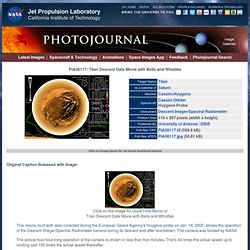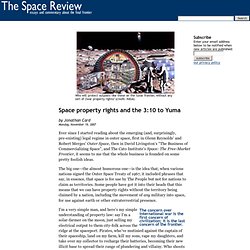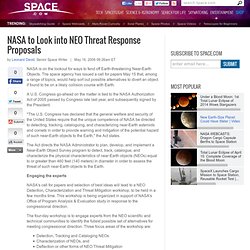

NASA sur Twitter : "Earth isn't the only ocean world in our solar system. Check out this infographic: #NASABeyond. Ocean Worlds.
Solar. Mars. Cassini. Catalog Page for PIA08117. Click on the image for QuickTime Movie ofTitan Descent Data Movie with Bells and Whistles This movie, built with data collected during the European Space Agency's Huygens probe on Jan. 14, 2005, shows the operation of the Descent Imager/Spectral Radiometer camera during its descent and after touchdown.

The camera was funded by NASA. Space property rights and the 3:10 to Yuma. By Jonathan CardMonday, November 19, 2007 Ever since I started reading about the emerging (and, surprisingly, pre-existing) legal regime in outer space, first in Glenn Reynolds’ and Robert Merges’ Outer Space, then in David Livingston’s “The Business of Commercializing Space”, and The Cato Institute’s Space: The Free-Market Frontier, it seems to me that the whole business is founded on some pretty foolish ideas.

The big one—the almost humorous one—is the idea that, when various nations signed the Outer Space Treaty of 1967, it included phrases that say, in essence, that space is for use by The People but not for nations to claim as territories. Some people have got it into their heads that this means that we can have property rights without the territory being claimed by a nation, including the movement of any military into space, for use against earth or other extraterrestrial presence. HartRAO: 50 years of scanning the skies. The 26m radio telescope at HartRAO First built by the US National Aeronautics and Space Administration (Nasa) as one of three tracking stations for its space programme, the Hartebeesthoek Radio Astronomy Observatory (HartRAO) celebrates its 50th anniversary this month.
At 26m, HartRAO’s radio antenna in the Magaliesberg is the largest working example in Africa. TechCentral’s Craig Wilson went to speak to staff about its history and its current work. Yuri Gagarin, Vostok 1 and the void of space, 50 years later. Cosmonauts at the Yuri Gagarin Training Centre in Star City, Moscow Oblast, have a ritual – before being shot into God’s maw, they urinate against the tire of the truck that will take them to the launch site.

They do this because Yuri Gagarin did it, on the clear morning before his legendary flight. It’s a beautifully human moment – one that reduces Gagarin’s achievement to an understandable scale. Defined by nerves, the first man to orbit earth emptied his bladder before blast-off. Tonight, half a century after that trip, earthlings across the planet will be celebrating the annual nerdfest Yuri’s Night. An alien's eye view of the solar system (w/ video) Update: check out our podcast, which features another conversation with Marc Kuchner about his research on colliding planets and the prospects for life in binary star systems.

With help from a supercomputer capable of 67 trillion calculations per second, astronomers at NASA Goddard have determined what our solar system would look like to an alien astronomer. The simulations track the interactions of 75,000 dust grains in the Kuiper Belt, which is an icy region out beyond Neptune where millions of small bodies (including Pluto) orbit the sun. "The planets may be too dim to detect directly, but aliens studying the solar system could easily determine the presence of Neptune -- its gravity carves a little gap in the dust," Goddard astrophysicist Marc Kuchner said in a press release yesterday. "We're hoping our models will help us spot Neptune-sized worlds around other stars. " NASAtelevision's Channel.
Comet Lulin (C/2007 N3) photo gallery. The Moon transits the Earth as seen by EPOXI. Volcanic Activity Shaped Mercury After All. PROVIDENCE, R.I.

[Brown University] — Scientists have long anguished over how little is known about Mercury, the innermost of the four terrestrial planetary bodies in our solar system. The gaps in knowledge covered such basic information as the planet's geology, how it was formed and evolved and whether its interior was still active. In 1975, the Mariner 10 spacecraft returned intriguing images that showed smooth plains covering large swaths of Mercury's surface. But scientists could not determine whether the plains had been created by volcanic activity or by material ejected from below the surface when objects had collided into it.
Thus, they could not reach a consensus over Mercury's geologic past. Now, a research team led by Brown University planetary geologist James Head has determined that volcanism played a central role in forming Mercury’s surface. “What this shows is that Mercury was not dead on arrival,” says Head, the paper’s lead author. “That’s a lot of lava,” Head says. Galaxy Zoo. First Photo From Space. Stellarium. DeepSkyStacker - Free. NASA to Look into NEO Threat Response Proposals. NASA is on the lookout for ways to fend off Earth-threatening Near-Earth Objects.

The space agency has issued a call for papers May 15 that, among a range of topics, would help sort out possible alternatives to divert an object if found to be on a likely collision course with Earth. A U.S.